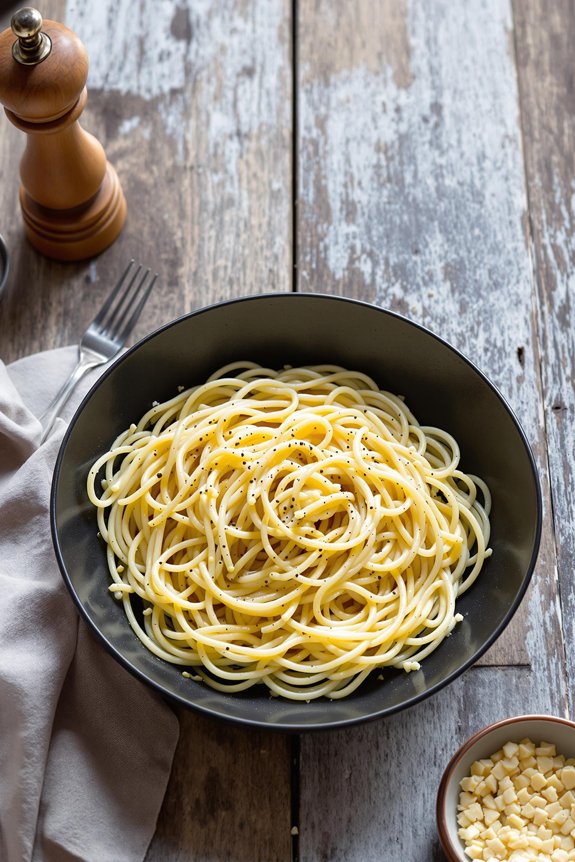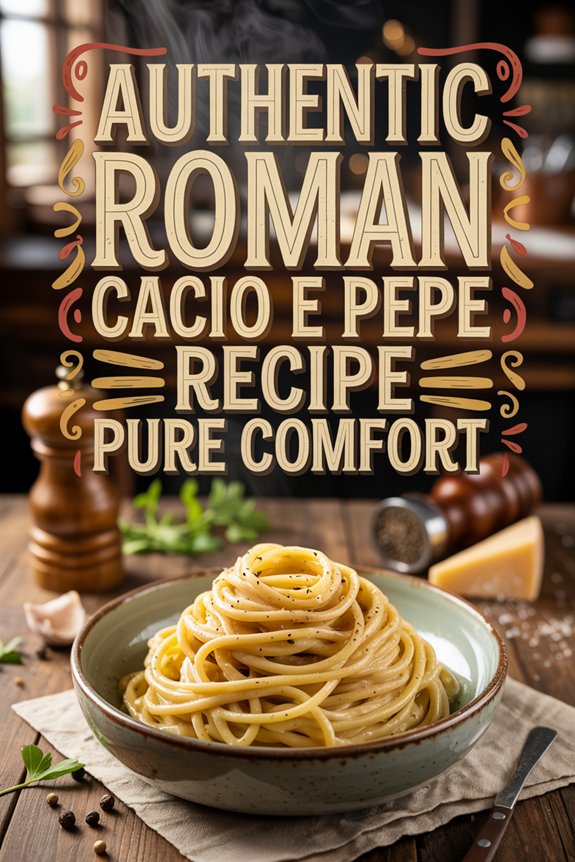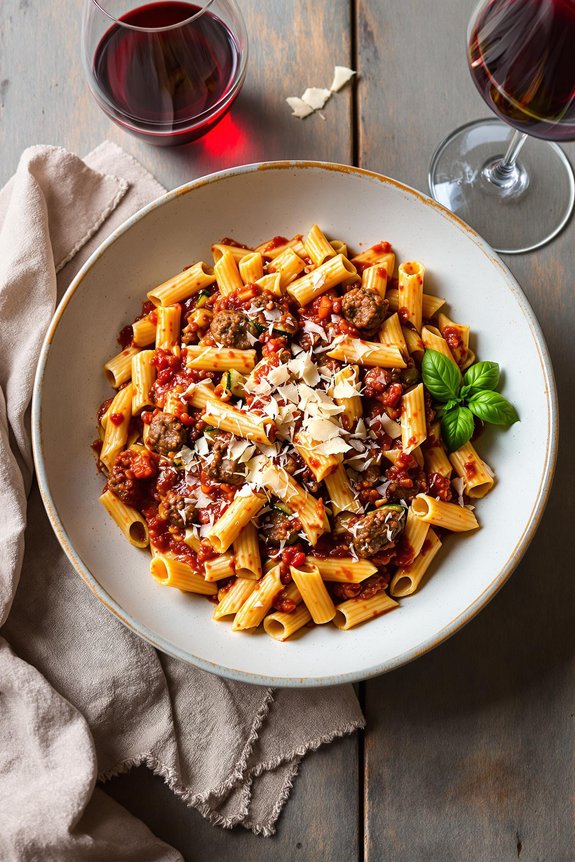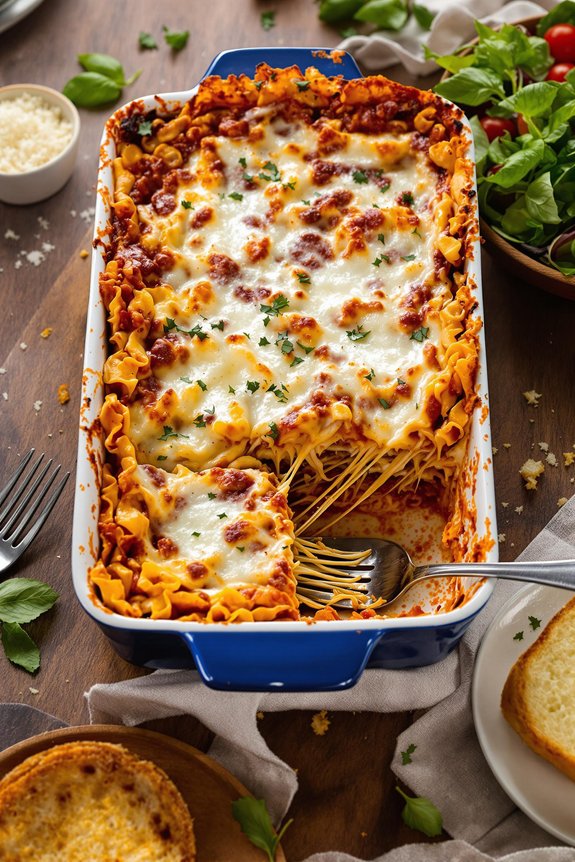Why You’ll Love this Authentic Cacio e Pepe
While many pasta dishes require a laundry list of ingredients, authentic Cacio e Pepe shines in its beautiful simplicity.
I’m obsessed with how just a handful of quality ingredients transform into something so luxuriously creamy and deeply satisfying.
You’ll love the peppery warmth that cuts through the rich, salty cheese, creating that perfect balance that makes Roman cuisine so beloved.
The technique might seem fussy at first—getting that emulsion just right—but isn’t that what makes cooking an adventure?
Plus, it’s my go-to for impressing dinner guests without spending hours in the kitchen.
Pure comfort in under 15 minutes.
What Ingredients are in Authentic Cacio e Pepe?
The beauty of Cacio e Pepe lies in its stunning simplicity. This iconic Roman pasta dish translates literally to “cheese and pepper,” and those two ingredients truly form the backbone of this culinary masterpiece. While some modern adaptations might try to complicate things with cream or other additions, authentic Cacio e Pepe relies on just a few quality ingredients that, when combined properly, create a silky, luxurious sauce that clings perfectly to every strand of pasta.
- 12 ounces spaghetti
- 4 tablespoons unsalted butter, at room temperature
- 1 tablespoon extra-virgin olive oil
- 2/3 cup grated Pecorino Romano cheese
- Salt, to taste
- Freshly ground black pepper, to taste (and plenty of it)
The key to extraordinary Cacio e Pepe is using the absolute best ingredients you can find. Splurge on high-quality Pecorino Romano—it’s the star of the show and pre-grated cheese simply won’t create the same silky texture.
As for the pepper, freshly cracked is non-negotiable, and don’t be shy with it. The name of the dish includes pepper for a reason!
The pasta cooking water, while not listed as an ingredient, is actually essential as its starchiness helps create that magical emulsion between the cheese and butter. Trust me, you’ll want to make this dish with authentic Italian pasta that releases just the right amount of starch during cooking.
How to Make this Authentic Cacio e Pepe
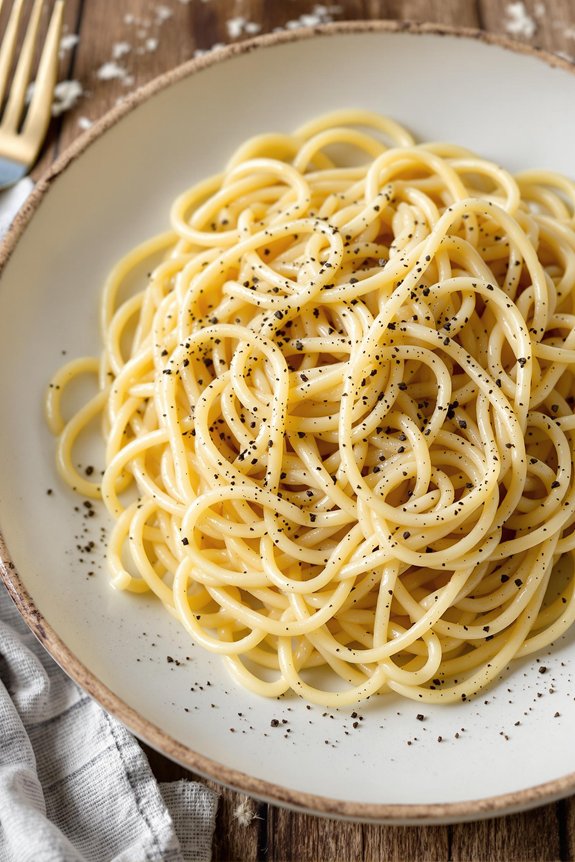
Making authentic Cacio e Pepe is a dance of timing and technique, but don’t worry—it’s actually quite simple once you understand the process. Start by bringing a large pot of salted water to a boil, then add 12 ounces of spaghetti and cook until it reaches that perfect al dente texture, which typically takes 8 to 10 minutes.
While your pasta bubbles away, prepare the heart of this dish by mashing 4 tablespoons of room-temperature unsalted butter with 1 tablespoon of extra-virgin olive oil and 2/3 cup of grated Pecorino Romano cheese in a large bowl until you’ve created a smooth, unified paste.
Now comes the vital moment that transforms these simple ingredients into magic. When your pasta is tender but still has that slight bite, drain it—but don’t rinse it and be sure to reserve about 1/2 cup of that starchy pasta water. The reserved water is liquid gold in this recipe.
Immediately transfer the hot spaghetti to your bowl with the cheese mixture and toss vigorously to coat every strand. This is where that pasta water comes into play; add it gradually while tossing until you’ve created a thick, creamy sauce that clings beautifully to the pasta. The heat from the pasta and the starchy water helps the cheese melt into a silky coating rather than clumping together, which is why timing matters so much here.
Season your masterpiece with salt and, true to its name, plenty of freshly ground black pepper—I’m talking several generous twists of the pepper mill. The pepper should be visibly speckling the pasta, providing both flavor and a delightful textural contrast to the creamy sauce.
Using premium cookware sets can significantly enhance your cooking experience by providing even heat distribution and better control when preparing delicate sauces like this one.
Divide your creation among four plates and serve immediately, as this dish waits for no one. The magic of Cacio e Pepe happens in that moment when hot pasta meets cheese, butter, and pepper, creating a symphony of flavors that’s so much greater than the sum of its parts.
Authentic Cacio e Pepe Substitutions and Variations
Now let’s talk about authenticity versus practicality when it comes to this classic Roman pasta dish.
While purists might insist on pecorino romano, you can substitute parmesan in a pinch. The flavor profile shifts slightly, but it’s still delicious.
Short on spaghetti? Bucatini or linguine work beautifully.
Some modern variations incorporate a touch of lemon zest or crushed red pepper—not traditional, but certainly tasty.
Can’t find high-quality pecorino? Look for aged cheeses with similar sharpness.
The key is maintaining that perfect balance between cheese, pepper, and pasta water—creating that silky, emulsified sauce that makes cacio e pepe so irresistibly comforting.
What to Serve with Authentic Cacio e Pepe
When it comes to pairing dishes with authentic cacio e pepe, simplicity remains the golden rule. This Roman classic shines brightest alongside understated companions that won’t overwhelm its peppery, cheesy perfection.
I recommend a crisp arugula salad with lemon vinaigrette, offering peppery notes that complement the pasta’s profile.
Roasted vegetables—think asparagus or cherry tomatoes—provide color and freshness. A glass of dry white wine, perhaps a Frascati from the Roman countryside, cuts through the richness beautifully.
For dessert? Keep it Italian with fresh berries drizzled with honey or a scoop of lemon sorbet.
Simple, clean flavors that cleanse the palate.
Final Thoughts
As I’ve shared this authentic cacio e pepe recipe with you, I’m reminded of why this dish has endured for centuries in Roman cuisine.
It’s simplicity at its finest—just pasta, cheese, and pepper creating something truly magical when prepared with care.
The beauty lies in its restraint.
No garlic, no herbs, no fancy additions needed.
Sometimes the most basic ingredients yield the most profound flavors, don’t you think?

